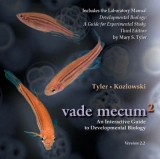
Vade Mecum 2
Sinauer Associates Inc.,U.S. (Hersteller)
978-0-87893-832-2 (ISBN)
- Titel erscheint in neuer Auflage
- Artikel merken
This comprehensive and interactive guide covers all aspects of laboratory work in developmental biology. Over 140 interactive videos and 300 labelled photographs take the student through the life cycles of model organisms used in developmental biology laboratories. The easy-to-use videos provide students with the concepts, vocabulary and motivation to enter the laboratory fully prepared. The CD-ROM includes chapters on the slime mold, sea urchin, the fruit fly and amphibian, and a new chapter on zebrafish looks at how to raise the organism and the effects of various teratogens on embryonic development. Also included are study questions for assessment of students' understanding of the exercises (or for their self-examination) with chapter quizzes that can be printed and laboratory skills guides. These are chapters concerned with techniques such as making the most of the microscope, which includes a "virtual microscope" that teaches how to achieve Koehler illumination, dark field illumination, and how to use polarizing filters. Two other chapters illustrate, in a step by step manner, how to make microdissecting tools and how to do histological techniques for paraffin sections.
Also included is a slide show on laboratory safety. The new third edition of Mary S. Tyler's laboratory manual, "Developmental Biology: A Guide for Experimental Study", is included in this CD-ROM. Featuring a new chapter on zebrafish and glossaries for each chapter, the manual, now in PDF format, can be printed for classroom use and teaches students to work as independent investigators on problems in development, and provides extensive background information and instructions for each experiment. It emphasizes the study of living material, intermixing developmental anatomy in an enjoyable balance, and allows students to make choices in their work. Hyperlinks connect words in the text with their definitions in the glossary and connect the table of contents entries for each chapter with their corresponding subsections. The manual contains challenging experiments requiring minimal equipment that are suitable for both large and small classes. Recipes for solutions, annotated bibliographies, and lists of scientific suppliers are also included. The web site www.developmentalbiology.net augments the CD-ROM, allowing convenient access to recipes from the lab book, a searchable glossary, developmental staging series for the model organisms, addresses of suppliers, and featured news stories.
MARY S.TYLER is Professor in the Biological Sciences Department at the University of Maine, Orono. Among several awards, she received the University's Distinguished Maine Professor Award in 1981 and the Most Inspiring Professor of the Year Award from University of Maine Student Government in 1997. Her research interests have been primarily in vertebrate embryonic development, studying organ development and tissue interactions using in vitro experimental techniques. - RONALD N.KOZLOWSKI is a Research Associate in the Biological Sciences Department at the University of Maine, Orono.He is a board member of Silva Borealis, a non-profit biology-based foundation in which he also serves as the chief technical officer. -
VADE MECUM2: Tools Microscope Histotechniques Slime Mold Gametogenesis Sea Urchin Sea Urchin UV Fruit Fly Chick Early Chick Mid Chick Late Flatworm Amphibian Zebrafish. DEVELOPMENTAL BIOLOGY A GUIDE FOR EXPERIMENTAL STUDY, THIRD EDITION: Getting Started Embryological Tools Using the Compound Microscope Cellular Slime Molds: Mycetozoa: Dictyostelium discoideum Gametogenesis Echinoid Fertilization and Development: Sea Urchins and Sand Dollars Sea Urchin Development: Effects of Ultraviolet Radiation Development of the Fruit Fly: Drosophila melanogaster Early Development of the Chick: Gallus domesticus 33 Hour Chick Embryo The Living Embryo and Making of Whole Mounts: 72 and 96 Hour Chick Embryo Histological Techniques Planarian Regeneration Amphibian Development Zebrafish Development.
| Erscheint lt. Verlag | 12.5.2003 |
|---|---|
| Zusatzinfo | glossary |
| Verlagsort | Sunderland |
| Sprache | englisch |
| Maße | 142 x 126 mm |
| Gewicht | 91 g |
| Themenwelt | Naturwissenschaften ► Biologie ► Genetik / Molekularbiologie |
| ISBN-10 | 0-87893-832-X / 087893832X |
| ISBN-13 | 978-0-87893-832-2 / 9780878938322 |
| Zustand | Neuware |
| Informationen gemäß Produktsicherheitsverordnung (GPSR) | |
| Haben Sie eine Frage zum Produkt? |
